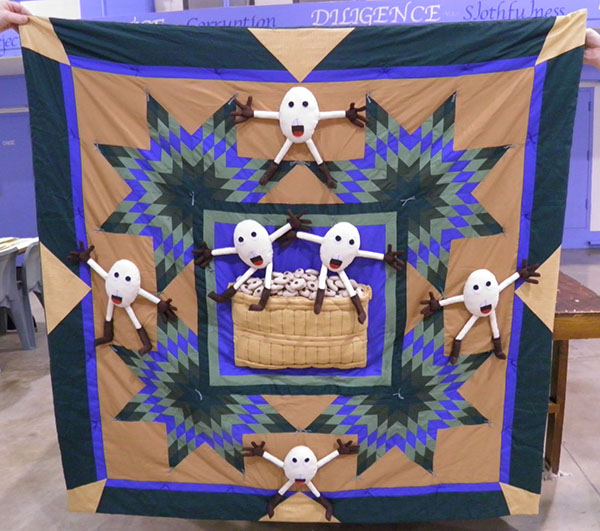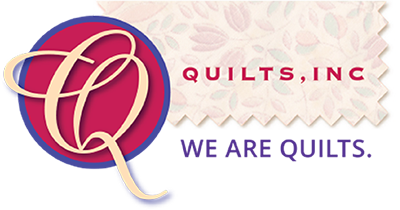Note: This continuing series reposts some of the most memorable columns of Suzy’s Fancy, which ran from 2009-2020. This piece originally ran in January 2013.
You might think that the men in the Purposeful Living Units Serve (P.L.U.S.) Program at the Wabash Valley Correctional Facility (WVCF), a maximum security prison in Carlisle, Indiana, wouldn’t care much about quilt patterns, color palettes, sewing techniques, fabrics, thread, or batting. You would be wrong! There are some serious quilters in this group.
The inmates, who are serving time for having committed the worst sorts of violent crimes (some of them are incarcerated for life without parole), are not the type you usually visualize when you think about quilters. Of course, stereotypes are always wrong, but clichéd views of both quilters and prison inmates would be utterly off the mark in the case of the WVCF’s P.L.U.S. Program quilters.
Jacquie Mize, a casework manager at the Nora Housing Unit where the P.L.U.S. Program offenders live, describes P.L.U.S. as a faith-and character-based re-entry program that offers offenders the opportunity to change their lives.
Admission into P.L.U.S. is difficult and highly competitive, and only 100 men out of a total prison population of over 2,000 are accepted into the 16-month program, which includes a core curriculum aimed at life-skills training and preparation for being a better citizen, whether inside or outside of prison.
Participants must take mandatory classes and they are required to complete 320 hours of community service, although most of the men contribute many times that amount. Since it began in 2005, the P.L.U.S. program has had the lowest incidence of conduct violations in the Indiana prison system, and P.L.U.S. graduates also have the lowest recidivism rate.
The program was recently selected by Indiana Lieutenant Governor Becky Skillman to receive her highest civil service honor, the “Partners in Progress Award.” This is the first time that the award has been given to any Indiana Department of Correction facility.
“Community service is one of the main aspects of the P.L.U.S. Program, and the quilting has become a big part of that,” says Mize. “We are known for our quilts.”

Indeed they are. The P.L.U.S. Program quilters and their quilts have been featured on national television, in national magazines, in local and state newspapers and in other publications, and have won prizes at the Indiana State Fair. The attention and accolades are well deserved, because the effort of these quilters is not just impressive for its quantity and creativity; it is downright inspiring.
The men are taught a basic sewing skills class using sewing machines in the housing unit. Correctional officers strictly monitor needles, pins, and any other sharp implements, and only round-tipped kids’ scissors are allowed for cutting fabric. (That latter fact alone should earn the respect of fellow quilters, who notoriously guard and value the sharpness of their rotary cutters and fabric scissors.) Once the sewing class is completed, volunteers from a local church teach quilting skills to the men.
All materials used by the P.L.U.S. quilters are donated and no state funds go toward the men’s quilting efforts. A fabric company offers its seconds to the program, and additional fabric donations and supplies come from churches and community connections. Obtaining enough batting is sometimes a problem, and food sales are held in order to raise money to purchase batts for the quilts.
Since the quilting program began, the men have made “thousands” of quilts (2,136 in 2011 alone), according to Jacquie Mize, and every one of them benefits the community in some way. Quilts made for a wide variety of community fundraisers raised over $10,000 in 2011.
Quilts have been given to nursing homes, homeless shelters, orphanages, and hospitals. Some have been given to government officials, such as Indiana’s Governor, or famous people, such as Miss America, that the men admire and to retiring Indiana Department of Correction employees.
One of the most notable projects has been that of making a memorial quilt for the families of each Indiana soldier who has died in the wars in Iraq and Afghanistan. The comfort that the memorial quilts provides to the grieving families is well evidenced by the thank-you letters that the men receive in return, usually from the mothers of the deceased.
Perhaps the highest-profile effort of the P.L.U.S. program quilters, however, is their Flag Quilt. “We have a very dedicated group of offenders in the program who are veterans,” says Mize. “The Flag Quilt was the brainchild of two of these men, Randy O’Brien and Kevin Henry, both former Marines. They really wanted to do something to honor all of the men and women throughout the country in every branch of service who have given their lives in the Iraq and Afghanistan wars.”

The quilt measures 40 feet in size and is a replica of the United States flag. On it is stitched the name of every serviceperson who has died in these wars. Names are obtained from a constantly updated government website. To date, the flag contains 6,298 names. With gratitude and sadness, the men add the names of all the men and women who have given their lives in the line of duty.

“Some of the men really get addicted to quilting,” remarked Mize. “But all of them get a lot out of it. It really does teach them to be better citizens.”
Kevin Henry says it best: “A quilt is just a bunch of scraps that aren’t much use on their own, but together they have beauty and purpose, just like us.”
Many quilters are familiar with the power of quilting to heal. The P.L.U.S. program quilters understand its redemptive powers as well.



